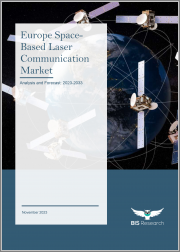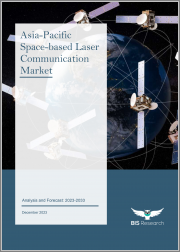
|
시장보고서
상품코드
1374892
유럽의 우주 기반 레이저 통신 시장 분석과 예측(2023-2033년)Europe Space-Based Laser Communication Market - Analysis and Forecast, 2023-2033 |
||||||
유럽의 우주 기반 레이저 통신 시장 규모는 2022년 2억 5,390만 달러에서 예측 기간 동안 10.55%의 CAGR을 기록하며 2033년 13억 1,330만 달러 규모로 성장할 것으로 예상됩니다.
유럽은 우주 기반 레이저 통신 시장의 성장세가 두드러지는 지역 중 하나로, Airbus Defense and Space, Eutelsat, SES, Thales Alenia Space 등 유럽의 주요 우주 및 통신 기업들로 구성된 컨소시엄이 SpaceX의 Starlink 시스템에 필적하는 위성 콘스텔레이션 제안 입찰에 참여했습니다. 유럽연합(EU)이 주도하는 이 프로젝트에는 2023년까지 26억 4,000만 달러의 막대한 자금이 투입됩니다. 또한 이 프로젝트는 유럽우주기구와 민간으로부터 추가 자금을 확보하여 전반적인 자금 조달 능력을 강화할 것으로 예상됩니다.
또한, 위성 간 링크(ISL)를 갖춘 2세대 위성의 도입으로 유럽의 우주 기반 레이저 통신 시장은 눈에 띄게 성장하고 있으며, AI, 전자제어 안테나(ESA), 부품 소형화, ISL 등 지상과 우주 모두에서 통신 성능을 향상시키는 최신 기술들이 이러한 성장을 주도하고 있습니다.
유럽의 우주 기반 레이저 통신 시장을 조사했으며, 시장 개요, 시장 성장에 영향을 미치는 각종 요인 분석, 시장 규모 추이 및 예측, 각 부문별/지역별/주요 국가별 상세 분석, 경쟁 상황, 주요 기업 분석 등의 정보를 정리하여 전해드립니다.
유럽의 우주 기반 레이저 통신 시장 : 소개
| 주요 시장 통계 | |
|---|---|
| 예측 기간 | 2023-2033년 |
| 2023년 평가 | 4억 8,170만 달러 |
| 2033년 전망 | 13억 1,330만 달러 |
| CAGR | 10.55% |
시장 구분:
세분화 1: 최종사용자별
- 정부 및 군
- 상업용
세분화 2: 솔루션별
- 우주 대 우주
- 우주 대 기타 애플리케이션
- 우주 대 지상국
세분화 3: 지역별
- 유럽 : 영국, 프랑스, 독일, 러시아, 기타
목차
제1장 시장
- 공급망 분석
제2장 유럽
- 세계의 우주 레이저 통신 시장 : 지역별
- 유럽
- 시장별
- 용도별
- 제품별
- 국가별
제3장 시장 : 경쟁 벤치마킹과 기업 개요
- 경쟁 벤치마킹
- HENSOLDT
- Mynaric
- ODYSSEUS SPACE SA
- Tesat-Spacecom GmbH & Co.
- Thales Alenia Space
- 기타
제4장 조사 방법
ksm 23.11.16“The Europe Space-Based Laser Communication Market Expected to Reach $1,313.3 Million by 2033.”
Introduction to Europe Space-based Laser Communication Market
| KEY MARKET STATISTICS | |
|---|---|
| Forecast Period | 2023 - 2033 |
| 2023 Evaluation | $481.7 Million |
| 2033 Forecast | $1,313.3 Million |
| CAGR | 10.55% |
The Europe space-based laser communication market is projected to reach $1,313.3 million by 2033 from $253.9 million in 2022, growing at a CAGR of 10.55% during the forecast period 2023-2033.
Europe is one of the prominent regions for the growth of the space-based laser communication market. A consortium of prominent European space and telecommunications companies, comprising Airbus Defense and Space, Eutelsat, SES, and Thales Alenia Space, has joined forces to submit a bid for a proposed satellite constellation that aims to rival SpaceX's Starlink system. With the European Union (EU) taking the lead, the project will receive a substantial funding commitment of $2.64 billion in 2023. Additionally, the project is expected to secure further financial support from the European Space Agency and private investments, bolstering its overall funding capacity.
Market Introduction
The introduction of second-generation satellites with intersatellite links (ISL) has resulted in a notable increase in the market for space-based laser communication in Europe. Modern technologies that improve communication performance both on Earth and in space, such as artificial intelligence (AI), electronically steered antennas (ESAs), component miniaturization, and ISLs, are primarily driving this rise.
Prominent firms that are creating massive constellations in low Earth orbit (LEO) and medium Earth orbit (MEO), such OneWeb, SpaceX, and Amazon's Project Kuiper, also have an impact on the market's trajectory. 2023 will see the integration of laser terminals by low Earth orbit satellites, such those operated by Starlink, into a constellation with optical intersatellite connections (OISLs), producing a strong mesh network in orbit. When it is fully deployed, Telesat's LightSpeed constellation also intends to include optical satellite links, while OneWeb is considering include optical links in its second phase of rollout. Inter-satellite links are made easier by the inherent nature of Amazon's Kuiper constellation.
To bring cutting-edge and novel products, major participants in this industry, such as Tesat-Spacecom GmbH & Co., SKYLOOM, Bridgecomm, and Mynaric, are substantially investing in research and development.
Market Segmentation:
Segmentation 1: by End User
- Government and Military
- Commercial
Segmentation 2: by Solution
- Space-to-Space
- Space-to-Other Application
- Space-to-Ground Station
Segmentation 3: by Region
- Europe - U.K., France, Germany, Russia, and Rest-of-Europe
How this Report Can Add Value
Product/Innovation Strategy: The product segment helps the reader understand the different types of components available for deployment and their potential globally. Moreover, the study provides the reader with a detailed understanding of the europe space-based laser communication market by end user and solution.
Growth/Marketing Strategy: The europe space-based laser communication market has seen major development by key players operating in the market, such as contract, collaboration, and joint venture. The favored strategy for the companies has been contracts to strengthen their position in the europe space-based laser communication market.
Competitive Strategy: Key players in the europe space-based laser communication market analyzed and profiled in the study involve major europe space-based laser communication companies providing components. Moreover, a detailed market share analysis of the players operating in the europe space-based laser communication market has been done to help the reader understand how players stack against each other, presenting a clear market landscape. Additionally, comprehensive competitive strategies such as partnerships, agreements, and collaborations will aid the reader in understanding the untapped revenue pockets in the market.
Methodology: The research methodology design adopted for this specific study includes a mix of data collected from primary and secondary data sources. Both primary resources (key players, market leaders, and in-house experts) and secondary research (a host of paid and unpaid databases), along with analytical tools, are employed to build the predictive and forecast models.
Data and validation have been taken into consideration from both primary sources as well as secondary sources.
Table of Contents
1 Market
- 1.1 Supply Chain Analysis
2 Europe
- 2.1 Global Space-Based Laser Communication Market (by Region)
- 2.2 Europe
- 2.2.1 Market
- 2.2.1.1 Key Manufacturers and Suppliers in Europe
- 2.2.1.2 Business Drivers
- 2.2.1.3 Business Challenges
- 2.2.2 Application
- 2.2.2.1 Europe Space-Based Laser Communication Market (by End User), Value and Volume Data
- 2.2.3 Product
- 2.2.3.1 Europe Space-Based Laser Communication Market (by Solution), Value and Volume Data
- 2.2.4 Europe (by Country)
- 2.2.4.1 France
- 2.2.4.1.1 Market
- 2.2.4.1.1.1 Key Manufacturers and Suppliers in France
- 2.2.4.1.2 Application
- 2.2.4.1.2.1 France Space-Based Laser Communication Market (by End User), Value and Volume Data
- 2.2.4.1.3 Product
- 2.2.4.1.3.1 France Space-Based Laser Communication Market (by Solution), Value and Volume Data
- 2.2.4.1.1 Market
- 2.2.4.2 Germany
- 2.2.4.2.1 Market
- 2.2.4.2.1.1 Key Manufacturers and Suppliers in Germany
- 2.2.4.2.2 Application
- 2.2.4.2.2.1 Germany Space-Based Laser Communication Market (by End User), Value and Volume Data
- 2.2.4.2.3 Product
- 2.2.4.2.3.1 Germany Space-Based Laser Communication Market (by Solution), Value and Volume Data
- 2.2.4.2.1 Market
- 2.2.4.3 Russia
- 2.2.4.3.1 Market
- 2.2.4.3.1.1 Key Manufacturers and Suppliers in Russia
- 2.2.4.3.2 Application
- 2.2.4.3.2.1 Russia Space-Based Laser Communication Market (by End User), Value and Volume Data
- 2.2.4.3.3 Product
- 2.2.4.3.3.1 Russia Space-Based Laser Communication Market (by Solution), Value and Volume Data
- 2.2.4.3.1 Market
- 2.2.4.4 U.K.
- 2.2.4.4.1 Market
- 2.2.4.4.1.1 Key Manufacturers and Suppliers in the U.K.
- 2.2.4.4.2 Application
- 2.2.4.4.2.1 U.K. Space-Based Laser Communication Market (by End User), Value and Volume Data
- 2.2.4.4.3 Product
- 2.2.4.4.3.1 U.K. Space-Based Laser Communication Market (by Solution), Value and Volume Data
- 2.2.4.4.1 Market
- 2.2.4.5 Rest-of-Europe
- 2.2.4.5.1 Market
- 2.2.4.5.1.1 Key Manufacturers and Suppliers in the Rest-of-Europe
- 2.2.4.5.2 Application
- 2.2.4.5.2.1 Rest-of-Europe Space-Based Laser Communication Market (by End User), Value and Volume Data
- 2.2.4.5.3 Product
- 2.2.4.5.3.1 Rest-of-Europe Space-Based Laser Communication Market (by Solution), Value and Volume Data
- 2.2.4.5.1 Market
- 2.2.4.1 France
- 2.2.1 Market
3 Markets - Competitive Benchmarking & Company Profiles
- 3.1 Competitive Benchmarking
- 3.2 HENSOLDT
- 3.2.1 Company Overview
- 3.2.1.1 Role of HENSOLDT in the Europe Space-Based Laser Communication Market
- 3.2.1.2 Product Portfolio
- 3.2.2 Business Strategies
- 3.2.2.1 Market Developments
- 3.2.3 Corporate Strategies
- 3.2.3.1 Partnerships, Collaborations, Contracts and Agreements
- 3.2.4 Analyst View
- 3.2.1 Company Overview
- 3.3 Mynaric
- 3.3.1 Company Overview
- 3.3.1.1 Role of Mynaric in the Europe Space-Based Laser Communication Market
- 3.3.1.2 Product Portfolio
- 3.3.2 Business Strategies
- 3.3.2.1 Market Developments
- 3.3.3 Corporate Strategies
- 3.3.3.1 Partnerships, Collaborations, Contracts and Agreements
- 3.3.4 Analyst View
- 3.3.1 Company Overview
- 3.4 ODYSSEUS SPACE SA
- 3.4.1 Company Overview
- 3.4.1.1 Role of ODYSSEUS SPACE SA in the Europe Space-Based Laser Communication Market
- 3.4.1.2 Product Portfolio
- 3.4.2 Corporate Strategies
- 3.4.2.1 Partnerships, Collaborations, Contracts and Agreements
- 3.4.3 Analyst View
- 3.4.1 Company Overview
- 3.5 Tesat-Spacecom GmbH & Co.
- 3.5.1 Company Overview
- 3.5.1.1 Role of Tesat-Spacecom GmbH & Co. in the Europe Space-Based Laser Communication Market
- 3.5.1.2 Product Portfolio
- 3.5.2 Business Strategies
- 3.5.2.1 Market Developments
- 3.5.3 Corporate Strategies
- 3.5.3.1 Partnerships, Collaborations, Agreements, and Contracts
- 3.5.4 Analyst View
- 3.5.1 Company Overview
- 3.6 Thales Alenia Space
- 3.6.1 Company Overview
- 3.6.1.1 Role of Thales Alenia Space in the Europe Space-Based Laser Communication Market
- 3.6.1.2 Product Portfolio
- 3.6.2 Business Strategies
- 3.6.2.1 Market Developments
- 3.6.3 Analyst View
- 3.6.1 Company Overview
- 3.7 Other Key Participants
4 Research Methodology
- 4.1 Factors for Data Prediction and Modeling

















